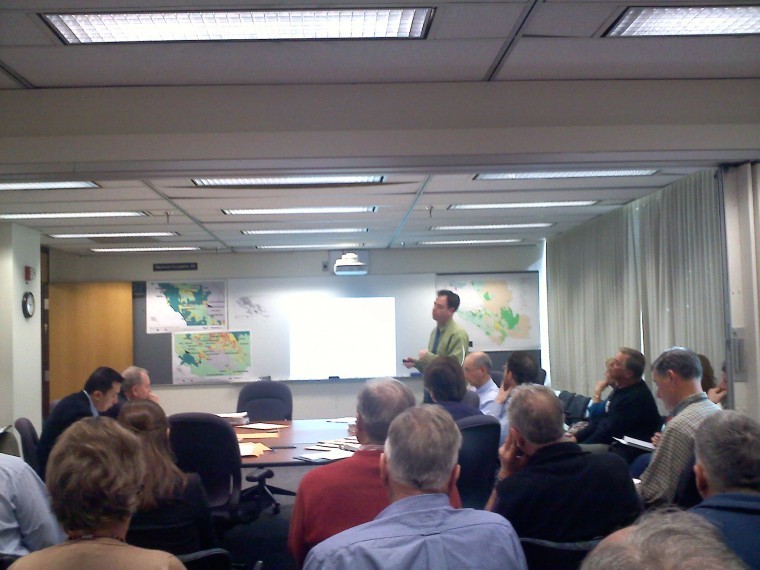
A cluster of local wine growers packed a conference room in the San Jose County Government Center Thursday for some straight talk with the Planning Department.
The issue at hand? County polices that regulate the wine industry.
The rules are nebulous, or in some cases, nonexistent, growers say.
When it comes to important topics such as promotional signage, hosting events, accommodating overnight tourists, expanding facilities, showcasing live music, serving food, etc., South County vintners want some clarity.
To address this, District 1 Supervisor Mike Wasserman initiated a comprehensive series of monthly meetings in September. The goal was to bolster agritourism by helping the burgeoning wine industry in South County blossom, rather than stymie growth.
The meetings were spearheaded by the Wineries Working Group (WWG), which consists of a dozen local winery owners, the Santa Clara County Farm Bureau, staff from the County Department of Planning and Development, Division of Agriculture, Department of Environmental Health, the Fire Marshal’s Office and Jane Howard, executive director of the Gilroy Welcome Center.
The WWG met nine times at the Santa Clara County Farm Bureau headquarters in Morgan Hill, where they hammered out a set of proposed guidelines for the county’s new winery ordinance. Thursday’s Planning Commission Workshop with county staff marks the first step in the next phase – a series of workshops and formal public hearings before the Planning Commission and Board of Supervisors.
A number of recognizable vintners from Gilroy, San Martin and Morgan Hill expressed their appreciation Thursday for the process initiated by Wasserman – but dually noted their concern with some of the recommendations. The proposed guidelines are a product created by wine growers and county representatives during the WWG meetings; a process marked by “spirited” debate, clashing opinions and “diverse interests.”
“I don’t see that this set of changes per the recommendations are going to change the universe in a meaningful way,” said Kirigin Cellars owner Dhruv Khanna, who said he has paid $300,000 in use, grading and building permits while trying to expand his winery and tasting room on Watsonville Road.
The WWG meetings were a “right first step,” he added, “but there’s a lot of work to be done. It’s a time to review the ordinances across the board…this process was excellent because we could actually sit in a room together and have the possibility that [the county] would actually listen to us.”
The WWG’s draft ordinance lays out significant recommendations some growers say they’re “pretty happy” with. Some topics are related to small gathering allowances, hosting non-commercial private events or industry marketing events (such as Passport Weekend), installing commercial kitchens or allowing guests to stay overnight in hostels, RVs, cottages, etc.
Because of time constraints and the county staff’s “control of the agenda,” however, the WWG’s recommendations “do not address many of the core regulatory obstacles to the much-needed investment, growth and sustainability of our county’s wineries,” wrote Khanna in a letter sent Wednesday to the Planning Commission.
One sticking point during Thursday’s meeting was that “wineries in South County are unique,” said Jennifer Williams, Executive Director of the SCC Farm Bureau.
When it comes to policy making, the county shouldn’t be comparing South County wineries with industry behemoths such as Napa and Sonoma, she said.
Rather, the county should be protecting and assisting the growth of “an industry that’s poised to take off.”
County Principal Planner Bill Shoe also pointed out that wineries shouldn’t be analogously lumped into the same category as other agriculture-related entities.
“People don’t want to have a wedding at an agriculture processing house,” he said. “A winery has that cache.”
Khanna, who once quipped, “I’m shocked that one doesn’t need a permit to scratch ones’ nose,” added that South County wineries will continue to be stagnated by the “vague and ambiguous language in the current ordinance” until the county gets things moving along.
“We are virtually the unknown cousins of Napa and Sonoma in the winery business,” he said. “We need to get stuff going. The biggest problem is dealing with all of these issues when you’re trying to expand your facilities.”
If local government really wants to give vintners a let up, Khanna suggested a heightened focus on marketing.
“We’re known for the outlets and garlic,” he said. “Not for our wines.”
A couple of residents who live on Burchell Road in Gilroy – a neighborhood nestled near a grouping of wineries along Hecker Pass and Watsonville Road – showed up to the meeting to address amplified music at wineries that can be heard “with our windows closed” until 9:45 p.m. on the weekends.
If there’s one thing growers unanimously stressed, however, the county’s existing noise ordinance should certainly be enforced – “but adding more noise ordinances isn’t going to change behaviors. Enforcing it will,” said Sheldon Haynie, co-owner of Lightheart Cellars in San Martin.
Williams reiterated this plea, asking that the county “not beef up the ordinance. The existing ordinance is sufficient, and should be enforced,” she said.
After being in the business for 41 years and watching many winemakers “struggle to stay alive,” veteran vintner Tom Kruse of Gilroy’s Thomas Kruse Winery stressed the overarching, common goal should be keeping vineyards in business so local growers can contribute to the economy.
“We have one of the finest growing climates in the entire world; something with a long tradition, rich culture and history,” he said. “We have a really special place. The potential to make world class wines is here.”
The next formal public hearing before the Planning Commission and Board of Supervisors will take place March 1 in the San Jose County Government Center.
Click on the links below to read past stories about the WWG:









